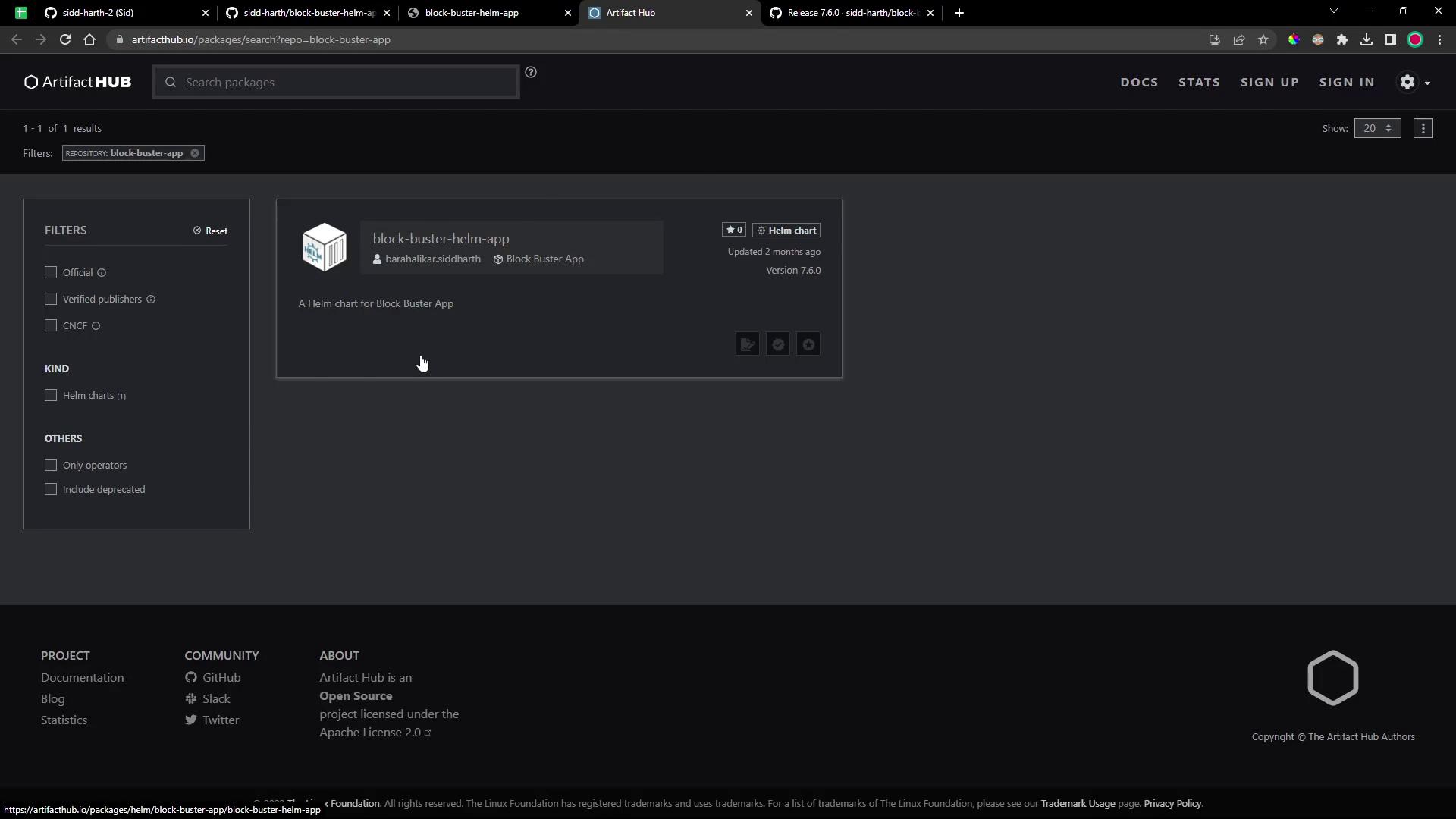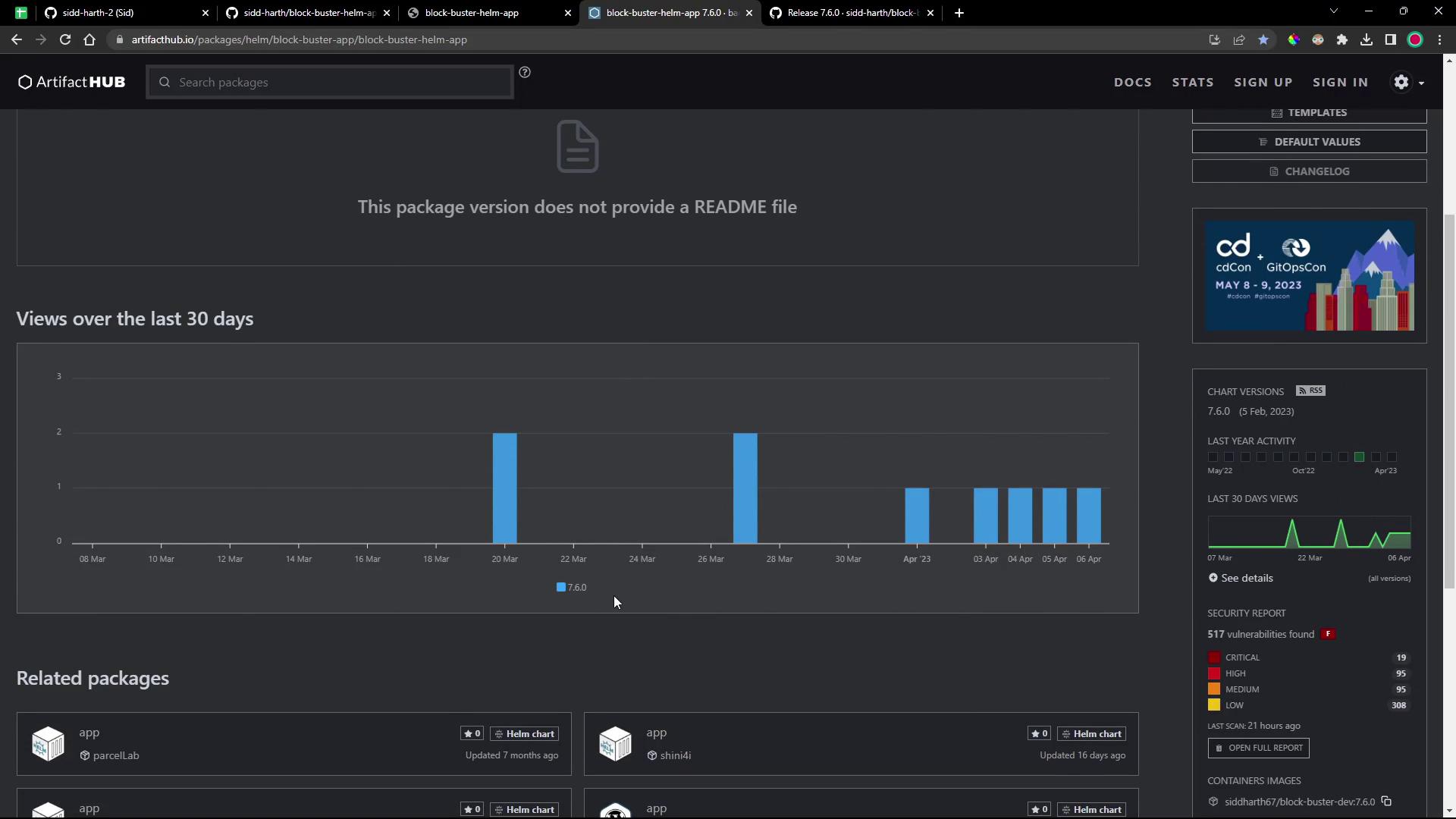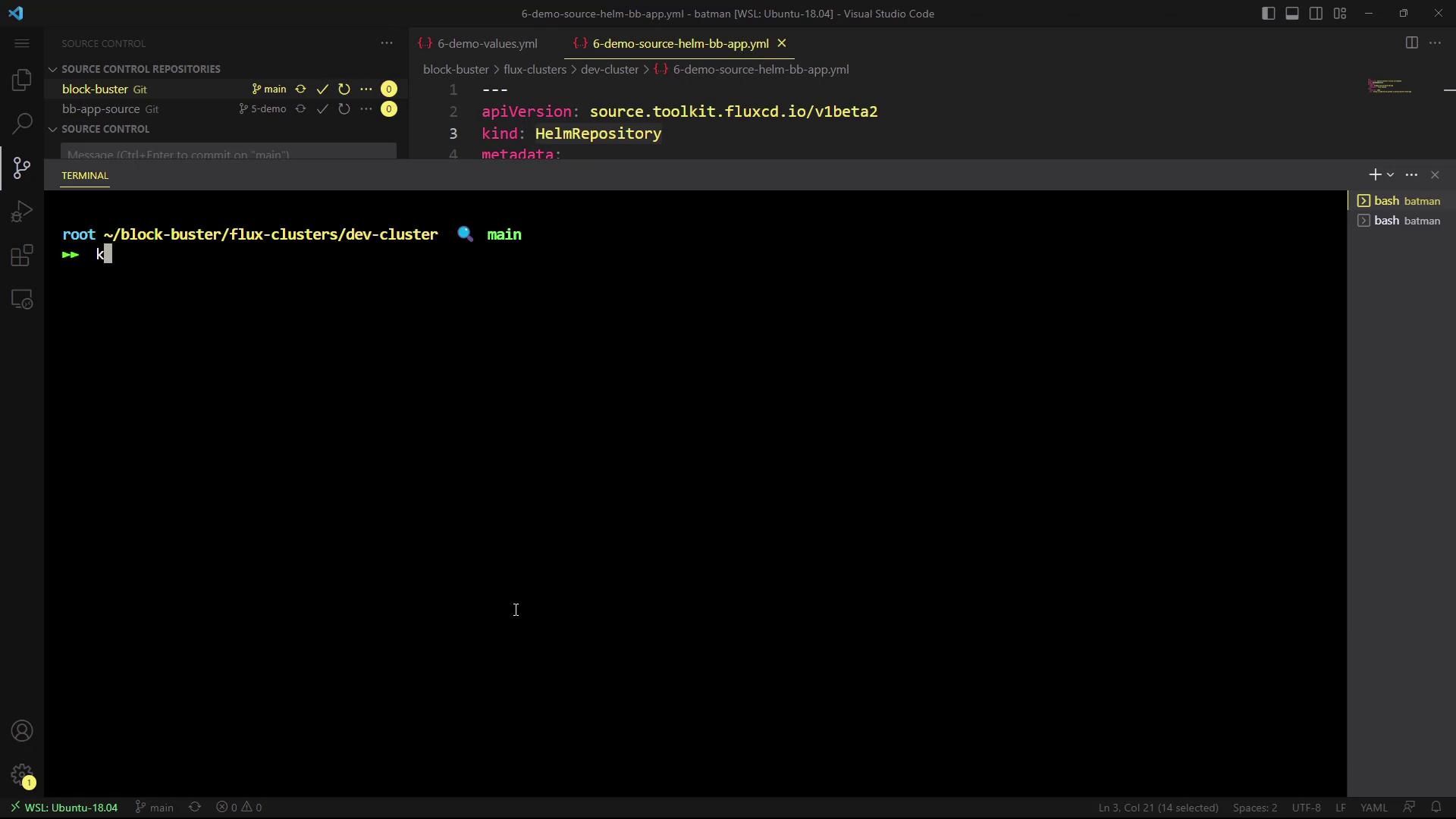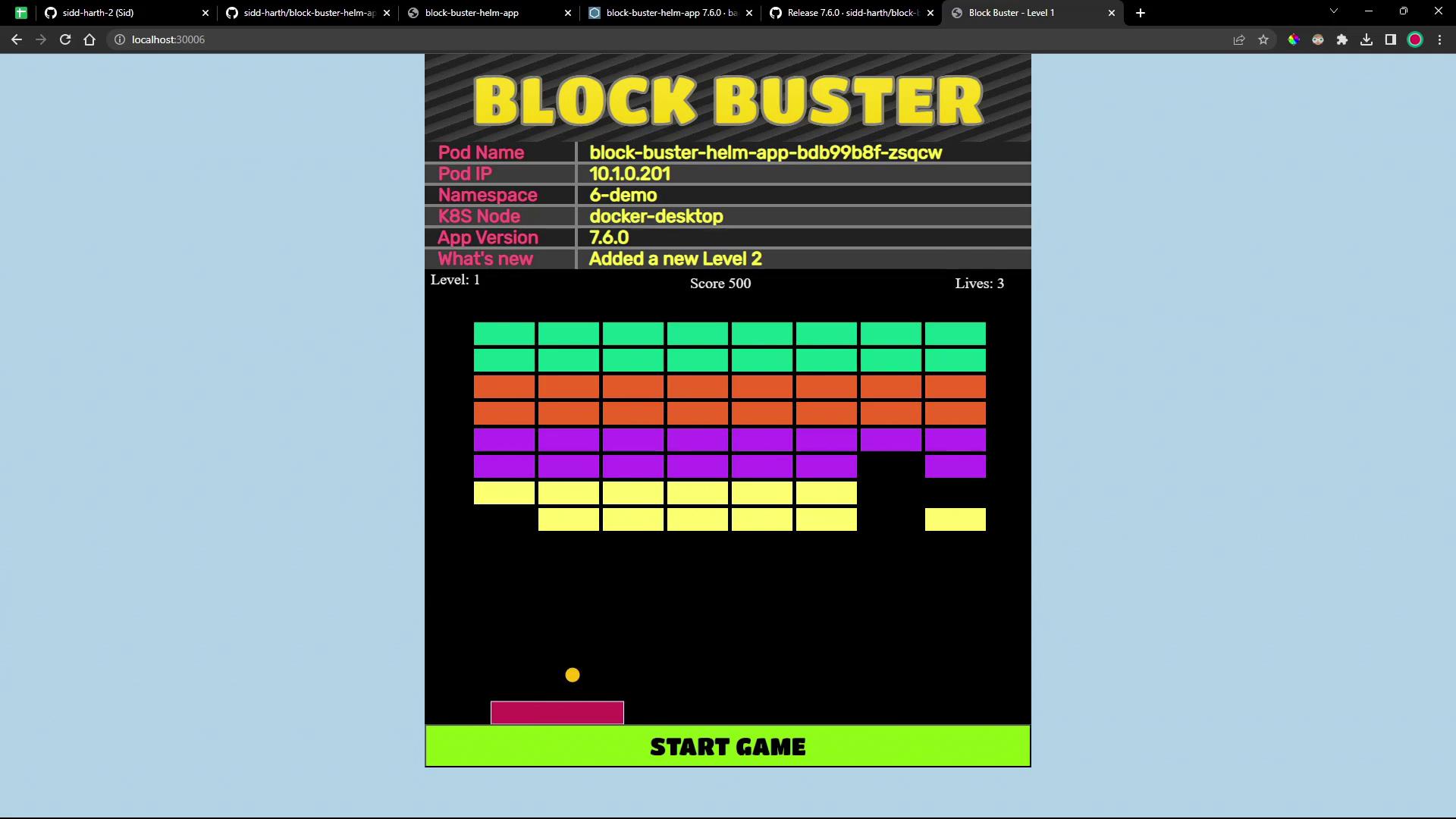GitOps with FluxCD
Helm Controller and OCI Registry
DEMO HELM Controller with Helm Repository as Source
In this walkthrough, we’ll package a Helm chart as a .tgz artifact, host it in a Helm repository (via GitHub Pages and Artifact Hub), then use Flux’s Source Controller and Helm Controller to automate its deployment.
1. Helm Chart Package on GitHub Releases
We’ve bundled our application into block-buster-helm-app-7.6.0.tgz and published it on the GitHub Releases page. Below is an example of the default values.yaml included in the chart:
# Sample values.yaml (for reference)
replicaCount: 1
service:
type: NodePort
nodePort: 30006
namespace:
name: 6-demo

2. Chart Listing on Artifact Hub
Our chart is also discoverable on Artifact Hub. Artifact Hub provides metadata, download statistics, and security reports for Helm charts.
# Extended sample values.yaml
replicaCount: 1
service:
type: NodePort
nodePort: 30006
namespace:
name: 6-demo
labels:
app:
name: block-buster
version: 7.6.0
env: dev
| Feature | Description |
|---|---|
| Repository URL | https://sidd-harth.github.io/block-buster-helm-app |
| Chart Version | 7.6.0 |
| Maintainer | sidd-harth |
| Install Command | helm install my-app block-buster-app --version 7.6.0 |


You could install manually:
helm repo add block-buster-app https://sidd-harth.github.io/block-buster-helm-app/
helm install my-block-buster-helm-app block-buster-app/block-buster-helm-app --version 7.6.0
3. Defining a HelmRepository in Flux
To automate updates, Flux’s Source Controller can track the Helm repository for new chart versions.
cd block-buster/flux-clusters/dev-cluster/
flux create source helm 6-demo-source-helm-bb-app \
--url https://sidd-harth.github.io/block-buster-helm-app \
--interval 1m \
--timeout 10s \
--export > 6-demo-source-helm-bb-app.yaml
This generates:
apiVersion: source.toolkit.fluxcd.io/v1beta2
kind: HelmRepository
metadata:
name: 6-demo-source-helm-bb-app
namespace: flux-system
spec:
url: https://sidd-harth.github.io/block-buster-helm-app
interval: 1m0s
timeout: 10s
Note
Adjust --interval and --timeout to suit your release cadence and network conditions.
4. Customizing Chart Values
Create a file named 6-demo-values.yaml to override default settings:
replicaCount: 2
service:
type: NodePort
nodePort: 30006
namespace:
name: 6-demo
labels:
app:
name: block-buster
version: 7.6.0
env: dev
Save it alongside your Flux manifests.
5. Creating a HelmRelease with Flux
Now define a HelmRelease to instruct Flux’s Helm Controller to deploy the chart:
flux create helmrelease 6-demo-helm-release-bb-app \
--chart block-buster-helm-app \
--interval 10s \
--target-namespace 6-demo \
--source HelmRepository/6-demo-source-helm-bb-app \
--values 6-demo-values.yaml \
--export > 6-demo-helm-release-bb-app.yaml
Generated manifest:
apiVersion: helm.toolkit.fluxcd.io/v2beta1
kind: HelmRelease
metadata:
name: 6-demo-helm-release-bb-app
namespace: flux-system
spec:
interval: 10s
targetNamespace: 6-demo
chart:
spec:
chart: block-buster-helm-app
sourceRef:
kind: HelmRepository
name: 6-demo-source-helm-bb-app
reconcileStrategy: ChartVersion
values:
replicaCount: 2
service:
type: NodePort
nodePort: 30006
namespace:
name: 6-demo
labels:
app:
name: block-buster
version: 7.6.0
env: dev
6. Committing to Git and Triggering Flux
git add \
6-demo-source-helm-bb-app.yaml \
6-demo-helm-release-bb-app.yaml \
6-demo-values.yaml
git commit -m "Add HelmRepository and HelmRelease for block-buster-app v7.6.0"
git push
Flux will detect the new manifests and begin reconciliation.
7. Verifying Flux Resources
Check the status of your HelmRepository:
flux get sources helm -n flux-system
NAME READY MESSAGE
6-demo-source-helm-bb-app True stored artifact: revision 'sha256:...'
List all source types:
flux get sources -A
Inspect your HelmRelease:
flux get helmreleases -A
NAME READY MESSAGE
6-demo-helm-release-bb-app True Release reconciliation succeeded
8. Exploring Source Controller Data
Enter the source-controller pod to view how Flux stores chart artifacts:

kubectl -n flux-system exec deploy/source-controller -- sh
/data$ ls -d */
gitrepository/ bucket/ helmchart/ helmrepository/
/data$ cd helmrepository/flux-system/6-demo-source-helm-bb-app/
/data/helmrepository/...$ cat index-*.yaml
/data$ cd ../helmchart/flux-system/6-demo-helm-release-bb-app/
/data/...$ tar -tf latest.tar.gz
# Shows Chart.yaml, values.yaml, templates/, etc.
| Resource | Stored Data |
|---|---|
| HelmRepository | Index files (versions, URLs) |
| HelmChart | Unpacked chart with templates & defaults |
9. Validating the Deployment
Once reconciled, Flux will create the target namespace (6-demo) and deploy your app:
kubectl -n 6-demo get all
You should see:
- 2 Pods (as per
replicaCount) - A Deployment
- A NodePort Service on port 30006
Access the game in your browser:
http://<node-ip>:30006

Try It Out
Starting with version 7.6.0, Block Buster introduces multiple levels. Complete Level One to unlock Level Two!
Links and References
Congratulations—you’ve automated the deployment of a Helm chart .tgz artifact using Flux’s Helm Controller and Source Controller!
Watch Video
Watch video content
Practice Lab
Practice lab